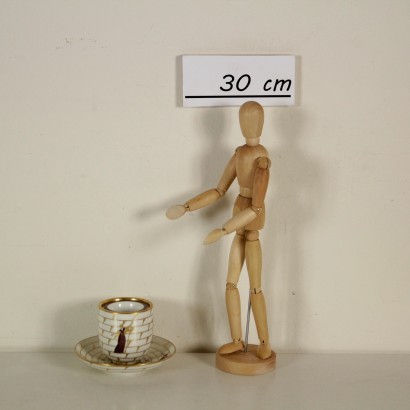Inkpot by Gio Ponti Ceramic Richard Ginori Vintage Italy 1920s
Features
Designer: Gio Ponti
Time: 1920s
Year: 1925
Production country: Italy
Material: Ceramic
Description
An inkpot designed by Gio Ponti (1891-1979), ceramic by Richard Ginori, 'pittoria di doccia'. Finely decorated by Gio Ponti. Manufacturer brand and year of production under the base. Manufactured in Italy, 1925.
Product Condition:
Good condition. Wear consistent with age and use. Any damage or loss is displayed as completely as possible in the pictures.
Dimensions (cm):
Height: 8
Diameter: 12
Additional Information
Designer: Gio Ponti
Gio (Giovanni) Ponti was born in Milan in 1891, and graduated in architecture from the Milan Polytechnic in 1921. In 1923 he participated in the 1st Biennial of Decorative Arts held at the ISIA in Monza and was subsequently involved in the organization of the various Triennials, both in Monza and in Milan. In the 1920s, Richard Ginori began his activity as a designer in the ceramic industry, and overall re-elaborated the industrial design strategy of the company; with ceramics he won the "Gran Prix" in 1925. In recent years his production is more based on classical themes and is close to the twentieth century movement. In the same years he also began his publishing activity: in 1928 he founded the magazine Domus. It will represent the center of the cultural debate of Italian architecture and design of the second half of the twentieth century. Ponti's activity extended in the 1930s: he organized the V Triennale di Milano in 1933, designed the sets and costumes for the Teatro alla Scala, and participated in the ADI Industrial Design Association, being one of the supporters of the award " Compasso d'oro "promoted by the La Rinascente warehouses. Among other things, he receives numerous national and international awards. In 1951, both Ponti's design and architecture became more innovative, abandoning the frequent links to the neoclassical past. It is here that the period of most intense and fruitful activity both in architecture and design begins, in fact, in the fifties, some of his most important works will be realized.Find out more about Gio Ponti with our insights:
Ninfea chair by Gio Ponti
Ponti's first masterpiece: the 646 Light
FineArt: Two Gio Ponti collectible 'Ninfea' chairs < br/> FineArt: Two 'Ninfea' chairs, Gio Ponti






















